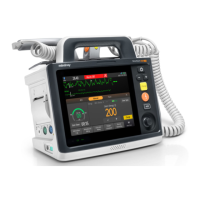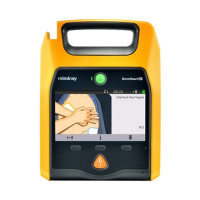A - 6
A.6 Communication Specifications
A.6.1 Wi-Fi Specifications (Wlink as Station)
Protocol IEEE 802.11a/b/g/n
Modulation mode BPSK, QPSK, 16QAM, 64QAM
Operating frequency 2412 MHz to 2472 MHz
5180 MHz to 5320 MHz, 5500 MHz to 5700 MHz, 5745 MHz to 5825 MHz
Wireless baud rate IEEE 802.11a: 6 Mbps to 54 Mbps
IEEE 802.11b: 1 Mbps to 11 Mbps
IEEE 802.11g: 6 Mbps to 54 Mbps
IEEE 802.11n: MCS0 to MCS7
Output power <20 dBm (CE requirement: detection mode- RMS)
Operating mode As station, access AP for data transmission
Data security Standards: WPA-PSK, WPA2-PSK, WPA-Enterprise, WPA2-Enterprise
EAP method: EAP-TLS, EAP-TTLS, PEAP-MSCHAPv2
Encryption: TKIP, AES
Distinct vision distance The distinct vision distance between the equipment and the AP: ≥ 50 m.
Alarm delay time of network
disconnection
The message and alarm delay of network disconnection between the
equipment and the CMS: ≤ 14 s.
Pre-hospital network performance
System capacity, interference immunity
and network stability
Meets the following requirements:
• The total delay of data transmission from the equipment to the CMS: ≤
10 s.
• The delay for the equipment related settings configured at the CMS to
be effective: ≤ 10 s.
• The data loss percentage of Wi-Fi communication over a 4-hour period: ≤
0.5%.
Test conditions Meets the following conditions simultaneously:
• One equipment supported by a single AP
• Each equipment can communicate with the CMS.
• The weakest strength of the AP signal where the equipment is located is
not less than -65 dBm.
• The distance between the interfering devices and the equipment is
greater than 20 cm. A Wi-Fi interference (no greater than -85 dBm) in the
same channel and a Wi-Fi interference (no greater than -50 dBm) in an
adjacent-channel are presented synchronously. The interfering devices
include, but are not limited to, 2.4 G wireless devices, cellular mobile
networks, interphones, cordless phones, and ESU equipment. The
interfering devices do not include Wi-Fi devices.
Hospital network performance
System capacity, interference immunity
and network stability
Meets the following requirements:
• The total delay of data transmission from the equipment to the CMS ≤ 2s.
• The delay for the equipment related settings configured at the CMS to
be effective: ≤ 2 s.
• The equipment connected to the network roam for 30 times, the data
loss percentage of Wi-Fi communication over a 24-hour period: ≤ 0.1%.

